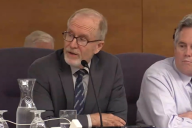You have /5 articles left.
Sign up for a free account or log in.
A report published today seeks to sort out the realities and misconceptions about state funding of higher education from a perspective rarely heard: that of the state budget officers themselves.
Most of the analysis of state funding of higher education comes from groups affiliated with colleges, and hence may be viewed with some skepticism by those who question whether states are spending too much. The new report's findings support many of higher education officials' assertions about state financing, including that states have cut their spending more sharply on higher education than on prisons or Medicaid, and that performance-based funding is not, itself, a solution to states' higher education budget problems.
But the report from the National Association of State Budget Officers also warns that public colleges are going to find it increasingly difficult to offset declines in state revenue by raising tuition, and that the institutions need to get more serious about reducing their costs instead, particularly through shared services and other efficiencies. The report, which was financed by the Bill & Melinda Gates Foundation, also calls for greater cooperation and understanding between public college leaders and state policy makers, who it says are often talking past one another.
Much of the report's description of the current situation regarding state financing of higher education is likely to sound familiar to those who follow such issues. Even as college enrollments have grown sharply in most places, many states have cut their spending on higher education (and most other activities other than Medicaid, which has eaten up ever-larger chunks of state budgets) and public colleges have shifted costs to students, through higher tuition and fees, to compensate.
Amid that overall pattern, though, the budget officers' report cites what it calls "evidence of a serious communication problem between state officials and higher education advocates." It is accurate, the report notes, that the proportion of state spending going to higher education is lower than in the past, and that per-capita spending on higher education has gone down more than similar spending on prisons and Medicaid as seen in the chart below.
It is also true that the state is now providing a far smaller portion of most public colleges' budgets than it was before.
But the latter spending has not fallen "quite to the level claimed by some presidents of research universities who also count research contracts and grants, hospitals and auxiliary enterprises inside their bottom lines," the report states. A far more appropriate way to assess the level of state support, the report asserts, is to look at how much of an institution's general operating costs are covered by the state.
Looking forward, if state spending is unlikely to recover any time soon, as the report and most analysts believe is the case, the status quo (mostly of offsetting state cuts with tuition increases) won't work. Changes will be necessary both in how states allocate their funds and what colleges do with them. "This report was really motivated by budget officers' feeling that the old model, where we'd slash the heck out of higher ed in bad times, give it above-average support in good times, and colleges raise tuition to make up for the cuts, isn't going to be sustainable," said Scott Pattison, executive director of the budget officers' association.
On the allocation side, states are likely to continue to alter their formulas for distributing state funds by tying money to performance rather than enrollment, but that alone is not a solution to states' budget problems, the report concedes.
Policy makers would be wise, the report suggests, to develop "differential funding strategies for different institutions or sectors... based on the contribution of those institutions to the public agenda." The report gives somewhat short shrift to that idea, perhaps a recognition of the political fallout that could occur from an approach that might lead to research universities in a state getting less than they do now, say, and community colleges more.
Almost no amount of state funding is going to make public higher education sustainable unless public colleges and universities get more serious about controlling their spending, especially when it comes to employee benefits (particularly retirement and health care), which the report concludes is driving significant portions of the tuition increases at many public institutions. "If employee benefit cost growth is not reduced, all new funds going to higher education -- and this increasingly means student tuition revenues -- may have to go to pay for employee benefits, rather than increased capacity or quality."










